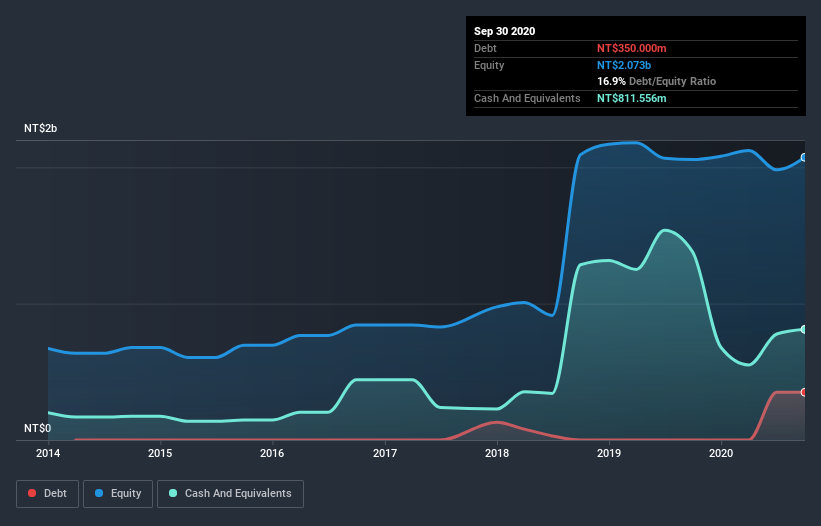- Taiwan
- /
- Electronic Equipment and Components
- /
- TWSE:3530
We Think Silicon Optronics (TPE:3530) Can Stay On Top Of Its Debt
Some say volatility, rather than debt, is the best way to think about risk as an investor, but Warren Buffett famously said that 'Volatility is far from synonymous with risk.' When we think about how risky a company is, we always like to look at its use of debt, since debt overload can lead to ruin. We note that Silicon Optronics, Inc. (TPE:3530) does have debt on its balance sheet. But the more important question is: how much risk is that debt creating?
When Is Debt Dangerous?
Debt and other liabilities become risky for a business when it cannot easily fulfill those obligations, either with free cash flow or by raising capital at an attractive price. Ultimately, if the company can't fulfill its legal obligations to repay debt, shareholders could walk away with nothing. However, a more usual (but still expensive) situation is where a company must dilute shareholders at a cheap share price simply to get debt under control. By replacing dilution, though, debt can be an extremely good tool for businesses that need capital to invest in growth at high rates of return. The first step when considering a company's debt levels is to consider its cash and debt together.
Check out our latest analysis for Silicon Optronics
What Is Silicon Optronics's Net Debt?
As you can see below, at the end of September 2020, Silicon Optronics had NT$350.0m of debt, up from none a year ago. Click the image for more detail. But it also has NT$811.6m in cash to offset that, meaning it has NT$461.6m net cash.

How Healthy Is Silicon Optronics's Balance Sheet?
The latest balance sheet data shows that Silicon Optronics had liabilities of NT$413.3m due within a year, and liabilities of NT$361.6m falling due after that. Offsetting this, it had NT$811.6m in cash and NT$34.6m in receivables that were due within 12 months. So it actually has NT$71.2m more liquid assets than total liabilities.
This state of affairs indicates that Silicon Optronics's balance sheet looks quite solid, as its total liabilities are just about equal to its liquid assets. So while it's hard to imagine that the NT$9.37b company is struggling for cash, we still think it's worth monitoring its balance sheet. Simply put, the fact that Silicon Optronics has more cash than debt is arguably a good indication that it can manage its debt safely.
Also positive, Silicon Optronics grew its EBIT by 22% in the last year, and that should make it easier to pay down debt, going forward. There's no doubt that we learn most about debt from the balance sheet. But ultimately the future profitability of the business will decide if Silicon Optronics can strengthen its balance sheet over time. So if you want to see what the professionals think, you might find this free report on analyst profit forecasts to be interesting.
But our final consideration is also important, because a company cannot pay debt with paper profits; it needs cold hard cash. While Silicon Optronics has net cash on its balance sheet, it's still worth taking a look at its ability to convert earnings before interest and tax (EBIT) to free cash flow, to help us understand how quickly it is building (or eroding) that cash balance. Over the last three years, Silicon Optronics saw substantial negative free cash flow, in total. While investors are no doubt expecting a reversal of that situation in due course, it clearly does mean its use of debt is more risky.
Summing up
While it is always sensible to investigate a company's debt, in this case Silicon Optronics has NT$461.6m in net cash and a decent-looking balance sheet. And we liked the look of last year's 22% year-on-year EBIT growth. So we don't have any problem with Silicon Optronics's use of debt. The balance sheet is clearly the area to focus on when you are analysing debt. However, not all investment risk resides within the balance sheet - far from it. Like risks, for instance. Every company has them, and we've spotted 2 warning signs for Silicon Optronics (of which 1 is significant!) you should know about.
If, after all that, you're more interested in a fast growing company with a rock-solid balance sheet, then check out our list of net cash growth stocks without delay.
When trading Silicon Optronics or any other investment, use the platform considered by many to be the Professional's Gateway to the Worlds Market, Interactive Brokers. You get the lowest-cost* trading on stocks, options, futures, forex, bonds and funds worldwide from a single integrated account. Promoted
New: Manage All Your Stock Portfolios in One Place
We've created the ultimate portfolio companion for stock investors, and it's free.
• Connect an unlimited number of Portfolios and see your total in one currency
• Be alerted to new Warning Signs or Risks via email or mobile
• Track the Fair Value of your stocks
This article by Simply Wall St is general in nature. It does not constitute a recommendation to buy or sell any stock, and does not take account of your objectives, or your financial situation. We aim to bring you long-term focused analysis driven by fundamental data. Note that our analysis may not factor in the latest price-sensitive company announcements or qualitative material. Simply Wall St has no position in any stocks mentioned.
*Interactive Brokers Rated Lowest Cost Broker by StockBrokers.com Annual Online Review 2020
Have feedback on this article? Concerned about the content? Get in touch with us directly. Alternatively, email editorial-team@simplywallst.com.
About TWSE:3530
Silicon Optronics
Designs, develops, and sells CMOS image sensors in Taiwan, Hong Kong, China, and internationally.
Flawless balance sheet with minimal risk.
Similar Companies
Market Insights
Community Narratives




